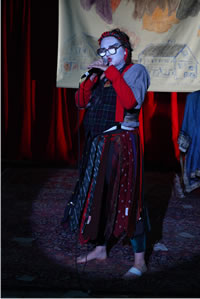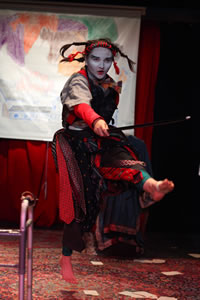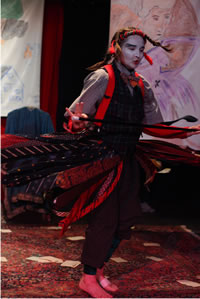
Dressed Up in Your Skin
and Bones
By Jennifer Cayer
The Truth: A Tragedy
By Cynthia Hopkins
Soho Rep
46 Walker St.
(closed)
In a post-show discussion, Cynthia Hopkins,
writer, composer, and performer of The Truth: A Tragedy
recalled this conversation with her father:
John Goodwin Hopkins:
Am I playing myself in the piece?
Cynthia Hopkins: I'm pretending to be you.
Is that OK?
John Goodwin Hopkins: If anyone's going to
do it who's not me, you'd be the next most qualified.
["Ancient Tragedy
vs. Modern Tragedy" FEED 5, May 25, 2010]
The wit and weight of parental legacy punctuates
Hopkins's one-woman reckoning in music, dance, and words with
the imminent, yet slow loss of her father to Parkinson's disease.
While John resides in a nursing home in Massachusetts, Hopkins
tells his jokes, dances the jig falsely promised to him after
brain surgery, and performs numbers both from and inspired by
his original musical, Onions! She rejects her brother's
suggestion to write a big commercial musical and leave the family
off-stage, instead offering a non-narrative collection of twenty-four
scenes that attest to a process at once idiosyncratic and somehow
familiar. It is a multi-media cabaret, as much about one woman's
oddball father as it is about the problems of prolonged aging
in America.
In 2009, Beijing-based artist Song Dong
installed the entire contents of his mother's home into the Museum
of Modern Art, in an art piece called Waste Not. Hopkins's
performance piece is similarly accompanied by a small museum of
her father's things. These range from the precious and revealing
pages of his unpublished memoir to the banal objects collected
over a lifetime. In this cabinet of curiosities accumulated pencils
become a Calder-esque mobile and a medicine cabinet becomes a
diorama of ailments. Viewers can pull a cord to light old lanterns
encased on the wall or even read whole pages from her father's
musical. The fact that the lanterns are not actually lit, but
illuminated by bulbs hidden below them is one of the many playful
and participatory aspects of the small collection. A sentimental
Duchamp, Hopkins elevates junk into art -- a daughter's disdain
into reverent acceptance -- and gives her father the audience
he always wanted.
The project began six years ago as a nascent
documentary film that was never made, Helping my Father Move.
It was Hopkins's way of coping with moving her father into assisted
living, and his willful "anti-organization" where heirlooms, used
Q-tips, and old eyeglasses comingle. This material ultimately
found expression in the theater where Hopkins literally moves
in the manner of her father. This live embodiment of her father
poignantly resonates with the particularity of Parkinson's deep
neurological assault. The erosion of motor and linguistic control
and sundering of the body's understanding of itself in space connect
to the art of the theater. Like Agnes Varda's memoir in and of
film, The Beaches of Agnes (2009), Hopkins seems invested
in what the medium of theater can do to the re-enactment of her
father and the re-telling of her stories. In the theater bodily
expressions and movements are played with, rehearsed, mastered,
and repeated for a live other. Part of Hopkins's homage here is
physical. She enacts both her father's dyskinesia via fitful and
labored dances and his verbal agility as a lifelong comedian of
one-liners. Her father -- a packrat, schoolteacher, sometime actor,
and wannabe sea captain -- is re-animated through the lens of
her performing body. We see him through her as a being momentarily
freed from illness.
 Hopkins
situates this piece on a map with other life performers including
Spalding Gray, Miranda July, and Anna Deavere Smith. In the opening
moment of the show, an empty portrait frame emerges from behind
the curtain. Hopkins then appears in clownish whiteface wearing
a skirt made out of her father's ties and oversized men's shoes.
The "truth" of her father that the show's title promises is missing,
out of the frame, and in excess. The stage, like her over-costumed
body, becomes its own disorderly exhibit, as it is systematically
covered with playing cards, love letters, a carrot, socks, shoes,
pills, records, a walker, and later a large fleshy dildo that
becomes the punctum of the visual mess. (While reading her father's
unpublished memoir, Hopkins learned of his homosexuality.)
Hopkins
situates this piece on a map with other life performers including
Spalding Gray, Miranda July, and Anna Deavere Smith. In the opening
moment of the show, an empty portrait frame emerges from behind
the curtain. Hopkins then appears in clownish whiteface wearing
a skirt made out of her father's ties and oversized men's shoes.
The "truth" of her father that the show's title promises is missing,
out of the frame, and in excess. The stage, like her over-costumed
body, becomes its own disorderly exhibit, as it is systematically
covered with playing cards, love letters, a carrot, socks, shoes,
pills, records, a walker, and later a large fleshy dildo that
becomes the punctum of the visual mess. (While reading her father's
unpublished memoir, Hopkins learned of his homosexuality.)
The performance and the museum work in
tandem, and in tension. While the museum exhibit at first glance
frames the mundane, the performance fills the portrait frame to
the brim. The detritus of a life is at first a nuisance, something
to pack up and away as the space of a life shrinks from home to
nursing home. The objects get in the way of life's forward march.
The performance, however, enacts a kind of conversion experience
on the stuff itself, the objects become re-charged with the specificity
of her stories. Like Plymouth Rock, the dullest of landmarks,
they become heroic relics; the act of rescue from obscurity charms
them. At the same time they become recognizable as totems for
the viewer's own privately curated drawers, closets, and basements.
Hopkins's ludic and loving attentions show how this stuff is at
once everyday and extraordinary, deeply personal and universal.
Hopkins's triumph in performance is the
subtle way that she invites the audience into what could be the
claustrophobic, opaque, all too specific space of another's pain.
Film is used to this end with unexpected and novel effects. Documentary
footage of John oddly evokes that grainy genre of family memories,
and he becomes a momentary shell for the elders we may know and
the ones we might become. In this most visually accurate of representations,
he seems most distant. Like the early French photographer Felix
Nadar's claim that a caricature is better able to capture the
essence of someone than a photograph, Hopkins's embodiments seem
to capture him, while the museum objects and documents serve to
capture the audience. Scenes dedicated to "Medical Professionals"
also offer familiar points of entry by depicting miscommunications
with doctors and the callousness of the health care system. At
one point, the screen flashes like a strobe light and a muffled
voice-over commands "keep eyes open." The audience is put in John's,
or in any patient's, place and can feel the impossibility of following
simple directions to move our bodies. Hopkins represents the challenges
of caretaking and gently replicates the experience of being in
a body that refuses to obey, to perform.
 The
recorded excerpts from an exercise tape that accompany the first
moments of the show also foreground the challenges of performance
for Hopkins. The voice-over invites basic bodily movement with
an ease that mocks the audience's knowledge of John's physical
state. Hopkins's dancing links her mobility to her father's immobility.
Later, during one of her songs, Hopkins also battles with a piano
that keeps snapping shut on her fingers. A conveniently placed
set of large plastic hands come to the rescue and allow "her"
to finish the song. With the hands in place, the music shifts
from Hopkins's live performance to the recorded. Throughout The
Truth, Hopkins sings in a solo voice accompanied by piano
or accordion without her usual band, Gloria Deluxe. And although
The Truth is distinctly less fantastical than her Accidental
Trilogy (2005, 2007, 2009), the prosthetics remind us that
sometimes the fake and the made-up are still needed to sing the
song, to approximate the truth.
The
recorded excerpts from an exercise tape that accompany the first
moments of the show also foreground the challenges of performance
for Hopkins. The voice-over invites basic bodily movement with
an ease that mocks the audience's knowledge of John's physical
state. Hopkins's dancing links her mobility to her father's immobility.
Later, during one of her songs, Hopkins also battles with a piano
that keeps snapping shut on her fingers. A conveniently placed
set of large plastic hands come to the rescue and allow "her"
to finish the song. With the hands in place, the music shifts
from Hopkins's live performance to the recorded. Throughout The
Truth, Hopkins sings in a solo voice accompanied by piano
or accordion without her usual band, Gloria Deluxe. And although
The Truth is distinctly less fantastical than her Accidental
Trilogy (2005, 2007, 2009), the prosthetics remind us that
sometimes the fake and the made-up are still needed to sing the
song, to approximate the truth.
The Truth ranges from funny to
distressing; likewise, her voice, which is reminiscent of Natalie
Merchant, has a rapid ability to swing from sweet to strident.
A few cabinets are staged as over-the-top comedy routines; Hopkins's
voice is a little bit too loud and a garish laugh track seems
to follow statements lifted from her dad, such as, "lately I've
been drifting into oncoming traffic." Although the content is
often not funny, the delivery is. In a cabinet entitled "The Theater"
Hopkins connects this phenomenon of making humor from losing control
with her own personal reckoning with her father and his illness.
She concludes that you can either consider him crazy or comic,
and in turn you can either go insane trying to deal with it, or
turn it into comedy, which she does. Ultimately, The Truth
is a testament to her own spiritual transformations, from frustration
to fascination with his junk and from resentment to forgiveness.
In the penultimate moment of the piece,
Hopkins slowly exits the stage while reciting a litany of death
clichés in her father's voice -- "Well, I'm finally ready to kick
the bucket… meet my maker…give up the ghost…dance the last dance."
These repeated words do not pronounce John dead. They humorously
render the multiple near-deaths that precede the last breath in
what can be a protracted process of dying. In the show, they also
evoke the reiterability of a life as re-arranged and seen anew.
If someone can almost die, again and again, perhaps they can also
live again and again. Hopkins insists on this in scene after scene
dedicated to his unique and singular life. She is able to survive
her father's death by assembling an ephemeral memorial.
 In
one particularly tender moment, Hopkins sings, "Oh father, please
listen, you're breathing, you're living/ And your teaching is
also living/ It doesn't matter if you wrote it down." Hopkins's
saving of things is her own theatrical answer to an ethical dilemma
facing those caring for patients who desire to die. Or, in her
father's words, a patient whose "exit keeps getting blocked."
What is one's responsibility to a loved one who wants to die?
How is it that we keep them safe? And what is safety in this condition
between pain and death? Hopkins keeps him safe in her saving.
And she dances and sings in the debris of his utter and extravagant
difference, in what amounts to an act of the deepest and most
difficult form of loving -- loving what you might not like, what
you know will never change, and what will surely be gone too soon.
In
one particularly tender moment, Hopkins sings, "Oh father, please
listen, you're breathing, you're living/ And your teaching is
also living/ It doesn't matter if you wrote it down." Hopkins's
saving of things is her own theatrical answer to an ethical dilemma
facing those caring for patients who desire to die. Or, in her
father's words, a patient whose "exit keeps getting blocked."
What is one's responsibility to a loved one who wants to die?
How is it that we keep them safe? And what is safety in this condition
between pain and death? Hopkins keeps him safe in her saving.
And she dances and sings in the debris of his utter and extravagant
difference, in what amounts to an act of the deepest and most
difficult form of loving -- loving what you might not like, what
you know will never change, and what will surely be gone too soon.
Near the end of her filmic self-portrait,
Agnes Varda says of her children and grandchildren: "Together,
they're the sum of my happiness. But I don't know if I know them.
I just go toward them." Hopkins, too, moves toward and into images
and imaginings of her father, while he continues to move ever
away.
Although he has yet to, and probably will
not be able to travel to see the piece, here is John Goodwin Hopkins's
own take on it:
Cynthia Hopkins: How
do you feel about this show that I'm making that's in homage
to you. Are you OK with it?
John Goodwin Hopkins: Yes. I think it will
be overstated on the virtuous side and, perhaps a little bit,
understated on the realistic side.
[from "One
Point Victory" a video by Cynthia Hopkins and director DJ Mendel]
I don't think I could put it any better
than that.
